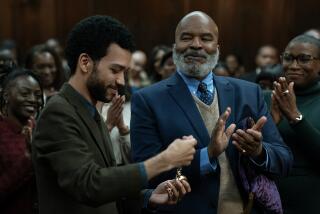Book review: ‘Celebrations of Curious Characters’ by Ricky Jay
To say that Ricky Jay does card tricks is, as Mark Singer once noted in the New Yorker, somewhat akin to suggesting that “Sonny Rollins plays tenor saxophone.” Jay is one of the greatest sleight-of-hand artists ever to fool and wow an audience. A few years back, at a theater in Westwood, I saw him quote a ballad by the French poet/thief François Villon, as translated by Dante Gabriel Rossetti, while simultaneously performing the famous party piece of his stage act, piercing the skin of a watermelon, or, as Jay puts it, the “thicker pachydermatous outer-melon layer,” with a single playing card flicked at 90 mph from between his fingers.
But Jay is not only a formidable card-handler and magician. He’s a collector and a scholar too, and once penned a short study titled “Cards as Weapons,” including reflections on card assassins through history, a concept that seemed pretty outlandish until I’d witnessed his assault on sturdy-skinned fruit. Copies of that long out-of-print volume now change hands for hundred of dollars on Amazon and EBay. His latest collection of arcane lore, “Celebrations of Curious Characters,” based around a series of four minute essays he wrote and performed a while ago for KCRW-FM (89.9), won’t do so much damage to the wallet, but does offer hours of shamelessly weird knowledge and fun.
Here are stories and meditations concerning human cannonballs, a poker-playing pig, performing rats, performing fleas, a bee hypnotist, Siamese twins, child prodigies, the memoirs of reformed gamblers, the soap scam, the language of the hustler and his victim, the apparition of religious iconography on tortillas, and “Matthew Buchinger, the Little Man of Nuremberg, the armless and legless calligrapher and magician.” Like Charles Dickens, who could never keep wooden legs out of his writing for long, Jay has a fondness for interesting characters and their oddball histories. “Mine is a particular misanthropy,” he notes. “I like little people. I like big people. I like conjoined people. I like attenuated people. I just have a lot of trouble with people.”
In a piece titled, simply, “Chickens,” Jay riffs on the subject of one of those arcane books he loves to collect and extol, in this case George R. Scott’s 1934 volume “The Art of Faking Exhibition Poultry,” a guide to “those dastardly con men who would alter, for their gain and glory, otherwise unsullied poultry.” Jay waxes poetic about the invention and showmanship that the challenges of physical human difference can inspire but nothing quite gets his juices flowing like the precise intricacies of deception. His knowledge of the con is encyclopedic, heroically Johnsonian. For instance, when unmasking the operations of three-card monte — a hustle just too blunt and mundane for Jay’s tastes — he does not hesitate to show how the trick is done. Here, faced with crooked chicken fanciers, he simply stands back and admires:
“We are familiar with chefs adding spice to enhance the taste of chicken, but corrupt poultry impresarios have less conventionally applied turmeric to touch up the feathers on certain females and have mixed saffron in oil to pigment the ungainly pale appendages of certain yellow-legged chickens,” he writes. “Women’s rouge has been unscrupulously dabbed on rooster lobes formerly too pallid to pass muster.”
Jay takes cool glee, not just in the oddities he describes, but in the raffish elegance of the language he conjures. That “corrupt poultry impresarios” is delicious. Who expected ever to find those three particular words conjoined in a gag? Discoursing upon the life of “Bismarck, The Pig of Genius,” he remarks: “Because of the rapid porcine growth rate, the careers of performing pigs, no matter how sagacious, were tragically foreshortened.”
This archly droll prose recalls Evelyn Waugh and Robert Hamer, who wrote like Oscar Wilde and directed the great film comedies “Kind Hearts and Coronets” and “School for Scoundrels.” Jay is an Anglophile, and a wonderful historian, and therefore a time traveler of the imagination — reading some of these essays, you sense he might have been happiest in the teeming streets of 1700s London, nimbly sidestepping cutthroats and coney-catchers while collecting, or indeed inking, pamphlets about the thief-taker Jonathan Wild and jailbreaker Jack Sheppard.
Providence, though, dropped Jay down in America in the 20th and 21st centuries, where he has fashioned a career — as glorious, as eccentric, in many ways, as those he cherishes and describes — to the issues of wonder and amazement. Secreted within these pages are nuggets of the autobiography that this fastidious, secretive man might or might not choose one day to write. “My father once gave me a model airplane in a futile attempt to bond,” he notes. It’s known that Jay didn’t get along with his parents, though he has never cared to spell out the details. Known too that he hit the road when very young. “We toured across Canada in the 1960s with an old-time music and magic extravaganza called ‘The Busted Toe Mud Thumper Show.’” He was enrolled, briefly, at the Cornell University School of Hotel Administration, we learn, and has acted in many movies made by his friend David Mamet (who provides an admiring introduction here) and in Bob Dylan rock videos. “Occasionally it is necessary to turn to arenas other than public radio to make ends meet,” he writes.
There’s something pure and single-minded about Jay, though, at least in the personality that shines through “Celebrations of Curious Characters.” He’s accurate, he’s witty, he’s bafflingly learned, and he uses that knowledge to bedazzle. Illustrations from his personal collection of broadsheets, posters, engravings and ephemera provide the book with its visual component. McSweeney’s produces with its customary quirky flair. It’s modest, great.
Rayner is the author, most recently, of “A Bright and Guilty Place: Murder, Corruption, and L.A.’s Scandalous Coming of Age.”
More to Read
Sign up for our Book Club newsletter
Get the latest news, events and more from the Los Angeles Times Book Club, and help us get L.A. reading and talking.
You may occasionally receive promotional content from the Los Angeles Times.






